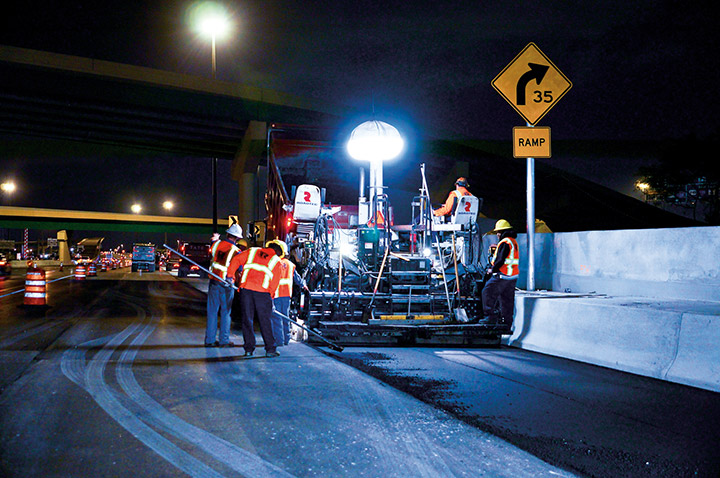Hot Mix Asphalt Paving: Your Entrance to Costs Angled Parking Solutions
Hot Mix Asphalt Paving: Your Entrance to Costs Angled Parking Solutions
Blog Article
Unlocking the Secrets of Warm Mix Asphalt Technology
Exploring the depths of warm mix asphalt innovation reveals a world where thorough processes and accurate formulations merge to shape our roads and framework. The blend of binders, accumulations, and fillers isn't merely a building job yet a strategic orchestration of resilience and efficiency.
Importance of Hot Mix Asphalt
Hot Mix Asphalt plays a critical duty in contemporary framework advancement due to its resilience and cost-effectiveness. As the most commonly made use of leading material for roads, freeways, and parking lots, Hot Mix Asphalt supplies a range of advantages that contribute to its importance in building and construction tasks.
The toughness of Warm Mix Asphalt stems from its structure, which consists of aggregates, binder, and filler materials that are carefully chosen and blended to fulfill particular performance demands. On the whole, the value of Warm Mix Asphalt in facilities growth can not be underrated, as it continues to be a cornerstone of contemporary construction techniques.
Components of Asphalt Mixes
The composition of asphalt blends contains thoroughly selected aggregates, binder, and filler materials that are important for achieving specific performance requirements. Aggregates are the main part of asphalt blends, giving toughness and security. These aggregates can be natural, such as crushed rock or crushed stone, or synthetic, like recycled products from old pavements. The binder, usually bitumen or asphalt concrete, holds the aggregates with each other and provides adaptability and resilience to the mix. The selection of the binder is crucial as it straight influences the mix's efficiency in various weather. Fillers, such as hydrated lime or Rose city cement, are made use of to enhance the mix's workability and aging resistance. Angled Parking.
The combination and proportion of these parts play a substantial role in figuring out the quality and efficiency of the asphalt mix. Engineers carefully create the mix to meet certain demands, considering factors like traffic volume, climate problems, and sidewalk life expectancy. Correct selection and harmonizing of aggregates, binder, and fillers are vital for creating durable, lasting asphalt pavements.
Mixing and Manufacturing Methods

When the aggregates are picked, the binder, commonly asphalt cement, is included in bind the products together. The binder's quality and quantity considerably influence the mix's adaptability, resistance, and strength to ecological elements. In addition, fillers like hydrated lime or Portland concrete might be integrated to improve specific features of the asphalt mix, such as its workability or wetness resistance.
Throughout production, the accumulations and binder are warmed, commonly in between 250-325 ° F(121-163 ° C ), to assist in blending and make certain proper finish of the aggregates. The blending procedure needs to be comprehensive to accomplish a homogeneous mixture that advertises the wanted performance characteristics of the asphalt. Different strategies, such as set blending or drum mixing, are used to accomplish constant and high-quality asphalt mixes for construction projects.
Elements Impacting Asphalt Performance
Elements affecting asphalt performance include a range of variables that influence the resilience, durability, and general top quality of asphalt pavements. One crucial element is the top quality of materials used in the asphalt mix. The type and source of aggregates, the binder high quality, why not find out more and the ingredients all play a significant role in determining the performance of the asphalt pavement. The gradation of accumulations is vital as it affects the mix's stability, workability, and resistance to fracturing and rutting.

Ecological conditions also influence asphalt efficiency. Temperature level variants, wetness infiltration, and website traffic lots can all influence the structural stability of the pavement. Design considerations, such as sidewalk thickness and drainage, are necessary in making sure the long-term efficiency of the asphalt sidewalk. By meticulously considering these engineers, contractors and aspects can optimize asphalt performance and improve the service life of pavements.
Sustainable Practices in Asphalt Modern Technology

Additionally, the advancement of warm-mix asphalt (WMA) innovations has actually gotten traction in recent times. WMA permits the production and placement of asphalt blends at lower temperatures compared to conventional hot-mix asphalt, causing decreased energy usage and greenhouse gas emissions. The usage of porous asphalt blends can assist minimize stormwater overflow concerns by enabling water to penetrate via the pavement and into the ground, promoting all-natural water purification and reenergize processes. By carrying out these sustainable methods, the asphalt industry can add to constructing a more environmentally friendly and resilient framework network.
Verdict
Finally, warm mix asphalt technology plays a vital duty in contemporary infrastructure growth because of its resilience and cost-effectiveness. By meticulously balancing elements, utilizing proper blending methods, and considering various elements, engineers can produce top notch asphalt mixes that withstand heavy traffic lots and harsh weather. Accepting sustainable techniques, such as utilizing recycled materials and warm-mix innovations, even click to investigate more boosts the ecological kindness of asphalt technology.
Mixing and production methods in hot mix asphalt modern technology involve the exact mix and processing of aggregates, binder, and fillers to develop a high-performance and durable asphalt mix.Factors influencing asphalt performance encompass an array of variables that impact the longevity, long life, and total top quality of asphalt sidewalks. Lasting methods in asphalt modern technology incorporate numerous initiatives aimed at lowering the environmental impact of asphalt manufacturing and paving processes. By including redeemed asphalt sidewalk (RAP) and recycled asphalt tiles (RAS) into brand-new asphalt blends, the sector can considerably decrease the consumption of raw materials and power, while additionally decreasing land fill waste.
WMA allows for the production and positioning of asphalt mixes at lower temperature levels compared to typical hot-mix asphalt, resulting in reduced energy usage and greenhouse gas discharges.
Report this page